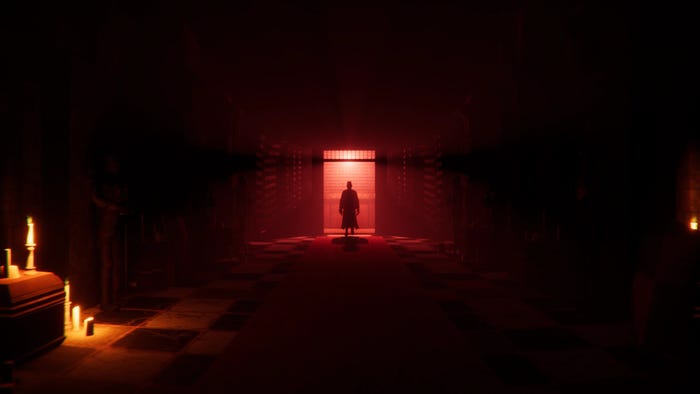Amid a "grim and despairing" nine-month crunch for Auto Assault, NetDevil managed to beat out 25 other firms to win the LEGO MMO deal -- but why? Gamasutra talks to the duo about LEGO Universe and hints of possible crossovers with other _L

The "hot thing" in recent months has been branded online worlds -- the industry's now got multiplayer spaces for everything from Hello Kitty to Build-a-Bear Workshop, and toy tie-ins like Webkinz are beginning to crop up everywhere. But LEGO Group director of business development Mark Hansen was already thinking of an online play space based on his company's iconic building block toys back in 1999 -- and the toy company just had to wait for the tech to get up to date, he claims. According to Hansen, the serious planning and partner investigation for building the upcoming PC downloadable LEGO Universe MMO began back in 2004. "Around 2004 and 2005, we started to see that more computers were coming into kids' bedrooms," Hansen says, noting that in order to develop a game like LEGO Universe targeted at 8-12 year olds, the era had to favor more kids having access to tech. "We took initiative and started searching for partners. We talked to over 26 different studios, and we picked one." That studio was Auto Assault and Jumpgate Evolution developer NetDevil. Hansen said the decision came down to the company's personality, its tech, and its willingness to work with LEGO's vision. "I still remember the day when we got the email from somebody at LEGO," says NetDevil lead producer Ryan Seabury. The initial missive was so simple that for a moment, the team thought it was a joke. But when it was confirmed, Seabury says, "I literally pushed away from my desk and was like, 'this could be the coolest thing ever.'" Hansen and Seabury agree that one reason for choosing NetDevil came down to the studio's interest in, as Seabury says, "pursuing genre and subject matter that wasn't necessarily run-of-the-mill" in online games. "There're so many untapped areas... I think LEGO saw that we were willing to take those risks, and the lessons we learned from our previous projects and the technology we built... were all big factors," says Seabury. "We had built up a lot of source code and a lot of knowledge over the years," says Seabury. "We really have a vision for what physics can be in games. That's something we pushed really hard in Auto Assault -- we were the first to push Havok as far as it went in an online environment," Seabury said. In fact, NetDevil broke Havok 1 a few times, and had to work closely with Havok's support team on things like object counts. At one point, Seabury says the team was running some 34,000 objects in a scene and encountered trouble. Calling up Havok for help revealed that NetDevil ought to have observed a 2,000 object maximum. "They learned a lot, we hope, from how we pushed it, and we learned how to make physics work -- not just online but massively multiplayer," says Seabury. The news that LEGO selected NetDevil came in the middle of what Seabury calls a "grim and despairing time" -- the midst of a nine-month crunch for the subsequently shut-down, NCSoft-published Auto Assault, an experience from which the company says it learned a lot of lessons. "We'd matured a lot as a company, and LEGO saw that," Seabury says. "We were at a scale they felt comfortable with." "So we started building stuff, and everyone would walk by and... have a zillion ideas and you could just see the concept was so night-and-day in comparison with Auto Assault. With LEGO, you just say 'imagine a LEGO universe,' and people get excited. It just had that kind of energy." Being the development studio elected to work with an IP like LEGO has the potential to be a major golden ticket. Travellers' Tales' development of LEGO Star Wars largely led them to an acquisition by Warner Bros. for a reported $200 million, for example -- if LEGO Universe does well, it could spell major success for NetDevil. So how can other developers looking to gain opportunities with major IP attract companies like LEGO? Offering some 'do's and don'ts,' Hansen stresses that the studio's personality played a major role. "They knew LEGO, and they knew how to focus back on who's our customer," he explains. "Many of the studios we went to said, 'here's the game we're going to make for you' -- we didn't want to hear the game they were going to make for us," Hansen says. "LEGO's been around 75 years -- it's not for [the studio] to rearrange what LEGO is." "Traveller's Tales got it exactly right. They knew exactly how to translate LEGO into very important IPs. Having an IP is not an automatic golden ticket," says Hansen -- it's the knowledge of how to turn that IP into a golden ticket that's precious. LEGO doesn't take studio pitches, either; they sought out studios who might be good matches for LEGO Universe one by one. What was the crucial area where other studios failed and NetDevil succeeded? "They should have said 'what kind of game are you looking for, and what matches your brand?'" Hansen says. And now that the relationship's established and the project is well in progress, aiming for a 2009 launch, is LEGO planning any synergies between the LEGO Universe MMO and the other LEGO game products and console titles that have been developed? "Yes," Hansen says simply, and smiles.
About the Author(s)
You May Also Like









